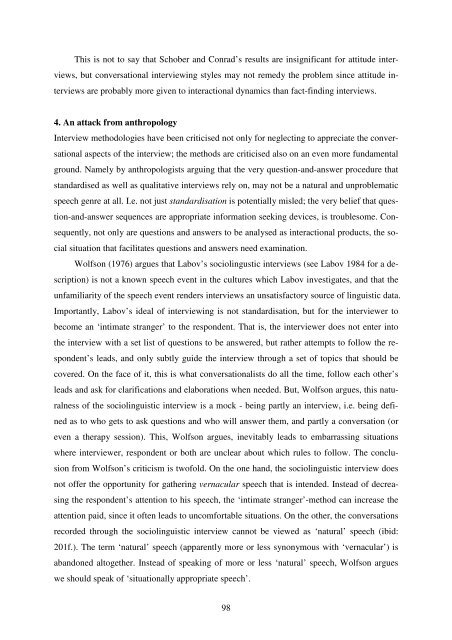Hør dog hvad de siger - Note-to-Self: Trials & Errors
Hør dog hvad de siger - Note-to-Self: Trials & Errors
Hør dog hvad de siger - Note-to-Self: Trials & Errors
Create successful ePaper yourself
Turn your PDF publications into a flip-book with our unique Google optimized e-Paper software.
This is not <strong>to</strong> say that Schober and Conrad’s results are insignificant for attitu<strong>de</strong> inter-<br />
views, but conversational interviewing styles may not remedy the problem since attitu<strong>de</strong> in-<br />
terviews are probably more given <strong>to</strong> interactional dynamics than fact-finding interviews.<br />
4. An attack from anthropology<br />
Interview methodologies have been criticised not only for neglecting <strong>to</strong> appreciate the conver-<br />
sational aspects of the interview; the methods are criticised also on an even more fundamental<br />
ground. Namely by anthropologists arguing that the very question-and-answer procedure that<br />
standardised as well as qualitative interviews rely on, may not be a natural and unproblematic<br />
speech genre at all. I.e. not just standardisation is potentially misled; the very belief that ques-<br />
tion-and-answer sequences are appropriate information seeking <strong>de</strong>vices, is troublesome. Con-<br />
sequently, not only are questions and answers <strong>to</strong> be analysed as interactional products, the so-<br />
cial situation that facilitates questions and answers need examination.<br />
Wolfson (1976) argues that Labov’s sociolingustic interviews (see Labov 1984 for a <strong>de</strong>-<br />
scription) is not a known speech event in the cultures which Labov investigates, and that the<br />
unfamiliarity of the speech event ren<strong>de</strong>rs interviews an unsatisfac<strong>to</strong>ry source of linguistic data.<br />
Importantly, Labov’s i<strong>de</strong>al of interviewing is not standardisation, but for the interviewer <strong>to</strong><br />
become an ‘intimate stranger’ <strong>to</strong> the respon<strong>de</strong>nt. That is, the interviewer does not enter in<strong>to</strong><br />
the interview with a set list of questions <strong>to</strong> be answered, but rather attempts <strong>to</strong> follow the re-<br />
spon<strong>de</strong>nt’s leads, and only subtly gui<strong>de</strong> the interview through a set of <strong>to</strong>pics that should be<br />
covered. On the face of it, this is what conversationalists do all the time, follow each other’s<br />
leads and ask for clarifications and elaborations when nee<strong>de</strong>d. But, Wolfson argues, this natu-<br />
ralness of the sociolinguistic interview is a mock - being partly an interview, i.e. being <strong>de</strong>fi-<br />
ned as <strong>to</strong> who gets <strong>to</strong> ask questions and who will answer them, and partly a conversation (or<br />
even a therapy session). This, Wolfson argues, inevitably leads <strong>to</strong> embarrassing situations<br />
where interviewer, respon<strong>de</strong>nt or both are unclear about which rules <strong>to</strong> follow. The conclu-<br />
sion from Wolfson’s criticism is twofold. On the one hand, the sociolinguistic interview does<br />
not offer the opportunity for gathering vernacular speech that is inten<strong>de</strong>d. Instead of <strong>de</strong>crea-<br />
sing the respon<strong>de</strong>nt’s attention <strong>to</strong> his speech, the ‘intimate stranger’-method can increase the<br />
attention paid, since it often leads <strong>to</strong> uncomfortable situations. On the other, the conversations<br />
recor<strong>de</strong>d through the sociolinguistic interview cannot be viewed as ‘natural’ speech (ibid:<br />
201f.). The term ‘natural’ speech (apparently more or less synonymous with ‘vernacular’) is<br />
abandoned al<strong>to</strong>gether. Instead of speaking of more or less ‘natural’ speech, Wolfson argues<br />
we should speak of ‘situationally appropriate speech’.<br />
98



